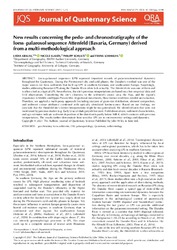New results concerning the pedo‐ and chronostratigraphy of the loess–palaeosol sequence Attenfeld (Bavaria, Germany) derived from a multi‐methodological approach
Krauss, Lydia; Klasen, Nicole; Schulte, Philipp; Lehmkuhl, Frank, 2021: New results concerning the pedo‐ and chronostratigraphy of the loess–palaeosol sequence Attenfeld (Bavaria, Germany) derived from a multi‐methodological approach. In: Journal of Quaternary Science: n/a - n/a, DOI: 10.23689/fidgeo-4306.
 |
Dokument öffnen: |
Loess–palaeosol sequences (LPS) represent important records of palaeoenvironmental dynamics throughout the Quaternary. During the Pleistocene's dry and cold phases, the Danube's riverbed was one of the major sources for loess sediments that built up LPS in southern Germany and southeastern Europe. Surprisingly, studies addressing Bavarian LPS along the Danube River often lack actuality. The Attenfeld site was one of them and is often cited as a typical LPS. Nevertheless, the site's previous interpretations are based on a few empirical data and field observations. Considering the site's closeness to the sediment's source area, the Alps, and the region's importance in Middle and Upper Palaeolithic migrational movements, those former renditions needed an evaluation. Therefore, we applied a multi‐proxy approach (including analyses of grain‐size distribution, element composition, and sediment colour attributes) combined with optically stimulated luminescence. Based on our findings, we conclude that the Attenfeld site's former interpretations might be too generalised. We identified units that were not mentioned by previous studies (e.g. Early Glacial dark greyish horizon). Field observations, sediment characteristics, and age estimates indicate sediment deposition of the dated units partly before MIS 4, which contrasts with previous interpretations. The results further demonstrate how sensitive LPS are to environmental settings and dynamics.
Statistik:
ZugriffsstatistikSammlung:
- Geologie [930]
This is an open access article under the terms of the Creative Commons Attribution‐NonCommercial License, which permits use, distribution and reproduction in any medium, provided the original work is properly cited and is not used for commercial purposes.

